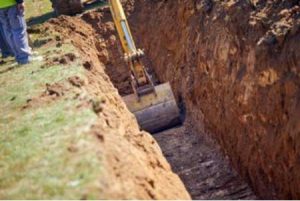 Employers must provide a workplace free of recognized hazards that may cause serious injury or death. But unfortunately, every month workers are killed in trench collapses.
Employers must provide a workplace free of recognized hazards that may cause serious injury or death. But unfortunately, every month workers are killed in trench collapses.
An excavation is any man-made cut, cavity, trench, or depression in an earth surface formed by earth removal.
A trench (Trench excavation) means a narrow excavation (in relation to its length) made below the surface of the ground. In general, the depth is greater than the width, but the width of a trench (measured at the bottom) is not greater than 15 feet.
Preventive Measures:
- Keep heavy equipment away from trench edges.
- Identify other sources that might affect trench stability.
- Keep excavated soil (spoils) and other materials at least 2 feet (0.6 meters) from trench edges.
- Know where underground utilities are located before digging.
- Test for atmospheric hazards such as low oxygen, hazardous fumes, and toxic gases when greater than 4 feet deep.
- Inspect trenches at the start of each shift.
- Inspect trenches following a rainstorm or other water intrusion.
- Do not work under suspended or raised loads and materials.
- Inspect trenches after any occurrence that could have changed conditions in the trench.
- Ensure that personnel wear high visibility or other suitable clothing when exposed to vehicular traffic.
SOIL IS HEAVY AND IT CAN BE VERY DANGEROUS!
Download flyer: STOTW_1124_Trenching-and-Excavations-Safety Download Spanish flyer: STOTW_1124_Trenching-and-Excavations-Safety_esp

